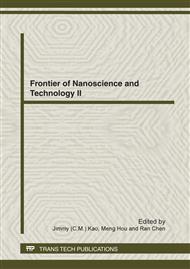[1]
AD Woolfson, RK Malcolm, K Campbell, DS Jones and JA Russell: J. Control. Rel. Vol. 67 (2000), pp.395-408.
Google Scholar
[2]
M Bi, SJ Hwang and KR Morris: Thermochim. Acta. Vol. 404 (2003), pp.213-26.
Google Scholar
[3]
PW Stott, AC Williams and BW Barry: J. Control. Rel. Vol. 50 (1998), p.297–308.
Google Scholar
[4]
PW Stott, AC Williams and BW Barry: Int. J. Pharm. Vol. 219 (2001), p.219: 161-76.
Google Scholar
[5]
CS Yong, YK Oh, SH Jung, J Rhee, H Kim, C Kim and H Choi: Eur. J. Pharm. Sci. Vol. 23 (2004), pp.347-353.
Google Scholar
[6]
M Lazerges, IB Rietveld, Y Corvis, R Céolin and P Espeau: Thermochim. Acta. Vol. 497 (2010), pp.124-8.
DOI: 10.1016/j.tca.2009.08.016
Google Scholar
[7]
CF Wahlgren and H Quiding: J. Am. Acad. Dermatol. Vol. 42 (1999), pp.584-9.
Google Scholar
[8]
S Nazzal, II Smalyukh, OD Lavrentovich and MA Khan: Int. J. Pharm. Vol. 235 (2002), pp.247-65.
Google Scholar
[9]
HG Morrison, CC Sun and S Neervannan: Int. J. Pharm. Vol. 378 (2010), pp.136-9.
Google Scholar
[10]
D Lindberg, M Revenga and M Widersten: J. Biotechol. Vol. 147 (2010), pp.169-71.
Google Scholar
[11]
RF Miller: US patent 20090247432, 2009 March 25.
Google Scholar
[12]
P Domınguez de Marıa and Z Maugeri: Curr. Opin. Chem. Biol. Vol. 15 (2010), pp.220-225.
Google Scholar
[13]
T Patel, Y Ishiuji and G Yosipovitch: J. Am. Acad. Dermatol. Vol. 57 (2007), pp.873-878.
Google Scholar
[14]
FA Al-Bayati: Ann. Clin. Microbiol. Antimicrob. (2009), 8: 20 doi: 10. 1186/1476-0711-8-20.
Google Scholar
[15]
CP Chang, TK Leung, SM Lin and CC Hsu: Colloids Surf., B. Vol. 50 (2006), p.136–140.
Google Scholar
[16]
Z Shunying, Y Yang, Y Huaidong, Y Yue and Z Guolin: J. Ethnopharmacol. Vol. 96 (2005), p.151–158.
Google Scholar
[17]
R Kotan, S Kordali, A Cakir, M Kesdek, Y Kaya and H Kilic: Biochem. Syst. Ecol. Vol. 36 (2008), pp.360-368.
DOI: 10.1016/j.bse.2007.12.003
Google Scholar
[18]
T Phaechamud, S Tuntarawongsa: CMICBA 2011. Chiang Mai University; 9-10 Aug 2011; Chiang Mai, Thailand (2011), p.135.
Google Scholar
[19]
Evonik Rӧhm GmbH Pharma Polymers: EUDRAGITÒ Acrylic Polymers for Solid Oral Dosage Forms. pp.1-14.
Google Scholar
[20]
JRV Flora, B Baker, D Wybenga, H Zhu, CM Aelion: Chemosphere. Vol. 70 (2008), p.1077–1084.
DOI: 10.1016/j.chemosphere.2007.07.060
Google Scholar
[21]
N Elgindy and W Samy: Int. J. Pharm. Vol. 376 (2009), pp.1-6.
Google Scholar


